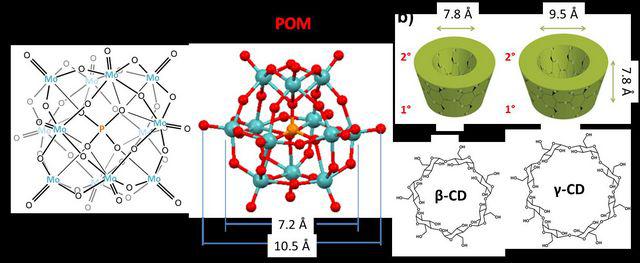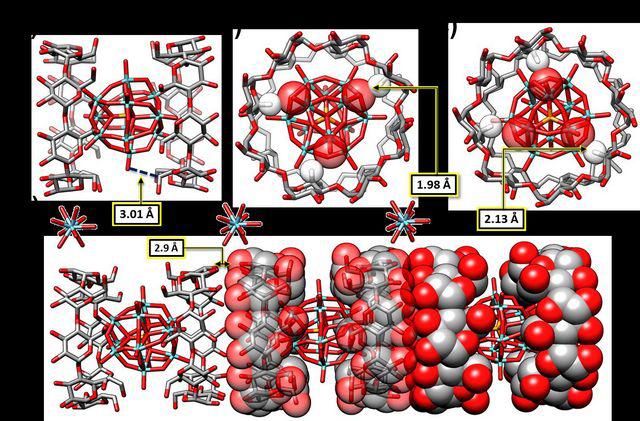BIT Professor makes breakthrough in Polyoxometalate?Chemistry
Translator: News Agency of BIT Zhang Andi
Editor: News Center of BIT Zhao Lin
Editor: News Center of BIT Zhao Lin
Under the support of BIT and the School of Chemistry and with the fund from the Scholar Program conducted by the China Scholarship Council, Li Hui, professor of the School of Chemistry of Beijing Institute of Technology (BIT), went to American Northwestern University to conduct a six-month collaboration research program with the famous chemist, Professor J. Fraser Stoddart and had made some ground-breaking progress in the field of polyoxometalate chemistry. The research outcome, under the name of Complexation of Polyoxometalates with Cyclodextrins, was published on a famous chemistry periodical, Journal of American Chemistry Society (137 (12), 4111-4118, 2015).
Inorganic-organic hybrid materials are a kind of new functional material. They have combined the features of inorganic materials with those of organic materials. Besides, the inorganic-organic hybrid materials tend to develop new physical and chemical properties because of the hybrid process, which makes this kind of materials irreplaceable in many fields such as chemistry, material engineering, environment protection as well as medicine.
There are two basic questions in the field of polyoxometalate chemistry: How to efficiently combine inorganic materials with organic materials and what are the effects of different combination methods on the properties of the materials? The answers are the key to design and make novel and controllable functional-oriented inorganic-organic hybrid materials. Professor Li Hui has been doing a lot of research in this field using the theory of coordination chemistry and supramolecular chemistry to research into various types of inorganic-organic hybrid materials. Furthermore, Li has figured out how to use X-ray crystallography to study the crystal structure of new materials and how to use the structure to instruct molecular design and synthesis. Through constant researches and corrections, Li eventually fulfilled her aim - designing and making the expected controllable functional-oriented materials.
The research work reported in the article, is to combine polyoxometalates [POMs, a heteropoly acid shown in Figure 1(a)] with cyclodextrins (CDs, a green organic compound shown in Figure 1(b)) using intermolecular force. Actually, POMs and CDs have been discovered and researched for over one hundred years. However, combining them together has never been done because the lumen of CDs is hydrophobic while the surface of POMs is hydrophilic. Furthermore, CDs are hard to crystallize and this also adds to the difficulty with combining them.
Inorganic-organic hybrid materials are a kind of new functional material. They have combined the features of inorganic materials with those of organic materials. Besides, the inorganic-organic hybrid materials tend to develop new physical and chemical properties because of the hybrid process, which makes this kind of materials irreplaceable in many fields such as chemistry, material engineering, environment protection as well as medicine.
There are two basic questions in the field of polyoxometalate chemistry: How to efficiently combine inorganic materials with organic materials and what are the effects of different combination methods on the properties of the materials? The answers are the key to design and make novel and controllable functional-oriented inorganic-organic hybrid materials. Professor Li Hui has been doing a lot of research in this field using the theory of coordination chemistry and supramolecular chemistry to research into various types of inorganic-organic hybrid materials. Furthermore, Li has figured out how to use X-ray crystallography to study the crystal structure of new materials and how to use the structure to instruct molecular design and synthesis. Through constant researches and corrections, Li eventually fulfilled her aim - designing and making the expected controllable functional-oriented materials.
The research work reported in the article, is to combine polyoxometalates [POMs, a heteropoly acid shown in Figure 1(a)] with cyclodextrins (CDs, a green organic compound shown in Figure 1(b)) using intermolecular force. Actually, POMs and CDs have been discovered and researched for over one hundred years. However, combining them together has never been done because the lumen of CDs is hydrophobic while the surface of POMs is hydrophilic. Furthermore, CDs are hard to crystallize and this also adds to the difficulty with combining them.

Figure 1.(a) Molecular structure of a heteropoly acid [PMo12O40]3+
(b) Molecular structure of β- and γ-CDs
Professor J. Fraser Stoddart not only has contributed greatly to the fields of organic chemistry and supramolecular chemistry, but also is an expert in POMs, while Professor Li has been studying and researching new compounds and complex crystallography for a long time. She also specializes in the design and making of functional coordination complexes. Hence, with their joint knowledge, the combination problem between POMs and CDs has been solved. To be more specific, they not only used the supramolecular self-assembling to combine [PMo12O40]3+ with β-CDs and γ-CDs to form two types of organic-inorganic hybrid materials under a mild and environmental-friendly synthesis condition, but used X-ray crystallography to thoroughly analyze the crystal structure of materials as well. Figure 2 demonstrates the crystal structure of organic-inorganic hybrid material created by [PMo12O40]3+ and γ-CDs. Professor Li and Professor Stoddart also used SAXS and WAXS techniques and 1H NMR to analyze the self-assembling process in the solution and part of the properties of the materials. The research result opened up a new era of CD-POM hybrid material research. It is predictable that this kind of hybrid materials will be of great application value in the fields like catalysis, photocatalysis and biological medicine.

Figure 2. Crystal structures of organic-inorganic hybrid material created by [PMo12O40]3+ and γ-CDs.
a) Side view of the basic unit
b) Top view of the basic unit
c) Bottom view of the basic unit
d) One-dimensional structure of tube-like supramoleculars (left to right: stick model to space-filling model)
Colors in Figure 2:
Mo: blue-green; La: blue; O: red; C: grey; P: orange; H: white.
To be concise, hydrogen atoms have been omitted in the structure (not including the ones in [C−H???O] bonds).
b) Top view of the basic unit
c) Bottom view of the basic unit
d) One-dimensional structure of tube-like supramoleculars (left to right: stick model to space-filling model)
Colors in Figure 2:
Mo: blue-green; La: blue; O: red; C: grey; P: orange; H: white.
To be concise, hydrogen atoms have been omitted in the structure (not including the ones in [C−H???O] bonds).

